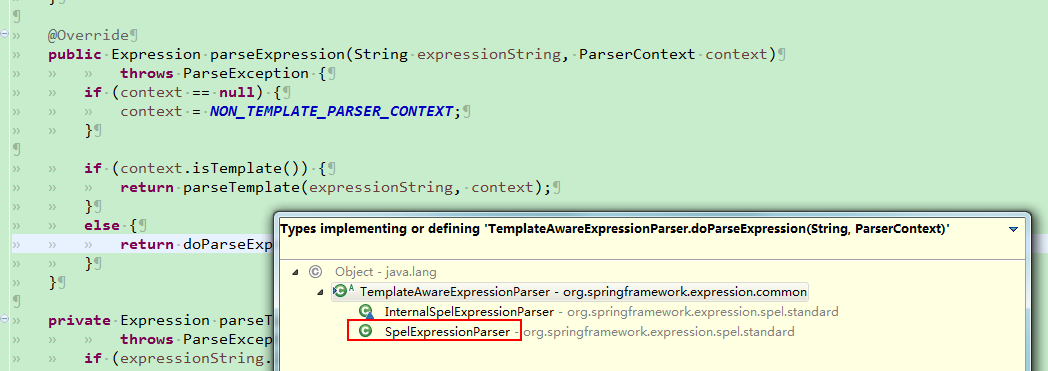概念
SpEL:Spring EL表达式
PropertyPlaceholderConfigurer:即org.springframework.beans.factory.config.PropertyPlaceholderConfigurer.java。我们通常通过配置一个PropertyPlaceholderConfigurer类型的bean,来将properties文件交给Spring来托管。
@Value、#{}、${}:通过@Value、#{}、${},可以读取受Spring托管的配置。(被托管的配置可能是properties文件、常量类的bean)
一、Spring EL表达式
EL表达式三个概念:
- 1. expression(表达式)
- 2. context(上下文)
- 3. root object(根对象)
Expression是从指定的上下文中获取相应的内容。
也就是说,Expression指定了要获取的property name,但还需要指定从什么地方获取该property value。
EL中可以从上下文context和root object中获取property value。
org.springframework.expression.Expression中提供了很多取property value的方法,如下几个比较重要:
从default standard context中获取property value
/** * Evaluate this expression in the default standard context. * @return the evaluation result * @throws EvaluationException if there is a problem during evaluation */ Object getValue() throws EvaluationException;
从指定的context中获取property value
/** * Evaluate this expression in the provided context and return the result of evaluation. * @param context the context in which to evaluate the expression * @return the evaluation result * @throws EvaluationException if there is a problem during evaluation */ Object getValue(EvaluationContext context) throws EvaluationException;
从指定的root object中获取property value
/** * Evaluate this expression against the specified root object * @param rootObject the root object against which properties/etc will be resolved * @return the evaluation result * @throws EvaluationException if there is a problem during evaluation */ Object getValue(Object rootObject) throws EvaluationException;
EL表达式的功能
| 英文 | 中文 |
|---|---|
| Literal expressions | 字面值表达式 |
| Boolean and relational operators | 布尔和关系操作符 |
| Regular expressions | 正则表达式 |
| Class expressions | 类表达式 |
| Accessing properties, arrays, lists, maps | 访问properties、arrays、lists、maps |
| Method invocation | 方法调用 |
| Relational operators | 关系操作符 |
| Assignment | 赋值 |
| Calling constructors | 调用构造器 |
| Bean references | bean引用 |
| Array construction | 构建数组 |
| Inline lists | 内联lists |
| Inline maps | 内联maps |
| Ternary operator | 三元操作符 |
| Variables | 变量 |
| User defined functions | 用户定义的功能 |
| Collection projection | 集合投影 |
| Collection selection | 集合选择 |
| Templated expressions | 模板化表达式 |
参考:
[1]http://www.cnblogs.com/larryzeal/p/5964621.html
[2]http://docs.spring.io/spring/docs/current/spring-framework-reference/htmlsingle/#expressions
二、 @Value、#{}、${}
http://www.cnblogs.com/larryzeal/p/5910149.html
Spring的属性注入,都依赖属性文件是受Spring容器管理的。
可以这么说,想要使用Spring的功能,那么,你的资源(实体、类、资源文件等)都必需受Spring容器的管理。当然,properties文件也不例外。
Spring对#{}和${}的支持,是通过org.springframework.expression.common.TemplateAwareExpressionParser来实现的。
public Expression parseExpression(String expressionString, ParserContext context) throws ParseException { if (context == null) { context = NON_TEMPLATE_PARSER_CONTEXT; } if (context.isTemplate()) { // 按${}来处理 return parseTemplate(expressionString, context); } else { // 按#{}来处理,即使用EL表达式来处理 return doParseExpression(expressionString, context); } }

EL对应的解析器:StandardBeanExpressionResolver
要将配置文件给Spring管理的话,一般会使用如下配置:
<bean id="propertyConfigurer" class="org.springframework.beans.factory.config.PropertyPlaceholderConfigurer"> <property name="locations"> <list> <value>classpath:/props/jdbc.properties</value> </list> </property> </bean>
这样我们就能在Spring环境下来使用它了。
@Value的值有两类:
- ① ${ property : default_value }
- ② #{ obj.property? : default_value }
就是说,第一个注入的是参数对应的property,第二个则是SpEL表达式对应的内容。 那个 default_value,就是前面的值为空时的默认值。注意二者的不同。
${key}
取properties文件中key对应的value。本质上是取PropertyPlaceholderConfigurer这个bean中的key对应的value。
#{object.field}
#是SpEl表达式,它取的是对象的属性。注意,这个对象object必需是Spring的Bean。
#{'${key}'}
$与#可以结合起来一起使用。可以参看例子:com.cn.kvn.framework.property_test.spel.SpelDomain.java